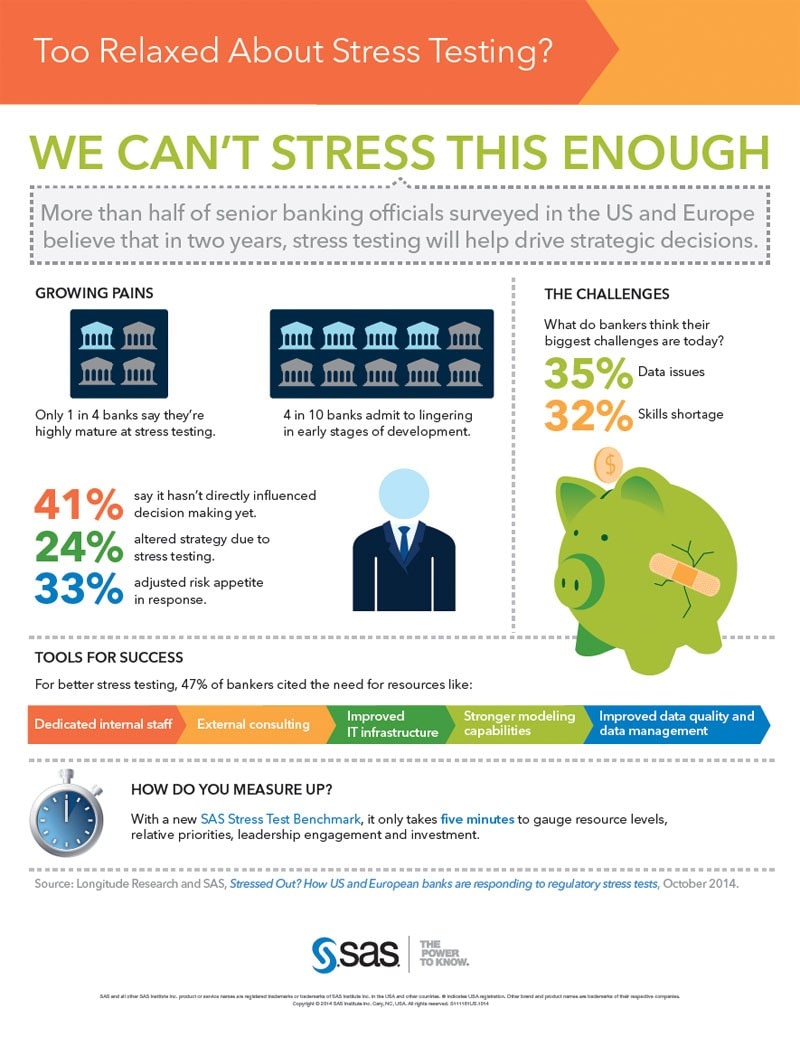Three UK banks under pressure from stress test
By Dale Stevens, Head of Risk at SAS UK and Ireland
As a result of the financial crash in 2008, the Bank of England will now regularly implement a stress tes’ to learn how banks will perform in the event of a severe economic downturn. Some of the variables in The Bank of England’s recent ‘war game’ included a 35 percent fall in house prices, a 30 percent fall in the value of the pound, a rise in unemployment to 12 percent, an increase in inflation to more than 6 percent and interest rates spiraling to 4.2 percent. In this doomsday scenario, three UK banks didn’t fare very well. Our new white paper and stress testing assessment tool can help you make sense of this complex area.
The failure of the three banks to stop the domino effect of economic hardship put forward by the Bank of England will be of little surprise to the market – especially when you consider the recent failure of 24 banks in the European stress tests. The imperative here is that the stress test is the reaction to that particular set of hypothetically harsh economic conditions. And, whilst a useful indicator of the British risk exposure, there is no so such thing as an ideal stress test.
The onus must be on having multiple real-time data points that can be adjusted to test how we will react to market conditions. By adopting more frequent stress tests across a wider range of market and custom scenarios, banks can proactively manage their future health and robustness.
It’s not just about compliance, it’s about taking a proactive approach to resilience testing – one that is all encompassing.
Banks lingering in the early stages of stress testing says survey
Our recent survey, completed in partnership with Longitude Research, revealed that only one in four North American and European banks had gotten beyond the early stages of stress testing development. Not only risky, this approach drives up costs through missed and wasted opportunities due to laborious manual collection and integration of data.
What’s more, just 24 percent of banks acknowledge making any changes to their strategic decisions as a result of stress testing, although 33 percent have adapted their institution's risk appetite in regards to making better business choices.
Respondents noted data issues (35 percent) and a skills shortage (32 percent) as their biggest challenges. They blame data quality and quantity for their struggles with data management, especially data aggregation and consolidation.
A significant number of banks that still have their work cut out for them.
James Watson
Editorial Director, Longitude Research
“Stress testing is now a fact of life for many banks. However, while a sizeable minority have clearly matured in their ability to deal with these tests, there are a significant number of banks that still have their work cut out for them," said James Watson, Editorial Director at Longitude Research. "This is especially true when it comes to the next step ahead … using stress testing as a tool to improve the wider management of the business."
To strengthen stress-testing frameworks, 47 percent of bankers said there is a need for resources dedicated to stress testing, including internal staff, external consultants and IT infrastructure. They said their other priorities will include fortifying their modelling capabilities and improving data quality. Although 41 percent of banks said past stress tests hadn't directly influenced business, more than half believe that in two years the tests will help drive strategic decisions. A fact borne out by the Bank of England’s report.
Stress testing is not just a compliance box-ticking exercise, it is an essential tool for banks to use in developing their risk management strategy.

Read More
Troy Haines, SVP and Head of Risk Research and Quantitative Solutions at SAS, was recently interviewed by Scott Robbin of the Argyle Journal about the benefits of having the risk and finance teams jointly develop and apply the main components of stress testing.
Gauge your bank's stress testing maturity
Get More Insights
Want more Insights from SAS? Subscribe to our Insights newsletter. Or check back often to get more insights on the topics you care about, including analytics, big data, data management, marketing, and risk & fraud.

